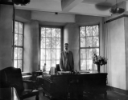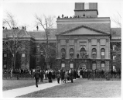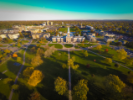Hayes Hall named to National Register of Historic Places

Hayes Hall on the University at Buffalo South Campus is easily distinguishable by its iconic clock tower. Photo: Douglas Levere
Published July 27, 2016 This content is archived.
By David J. Hill
From late-19th-century insane asylum to 21st-century architecture and planning education facility, iconic building has a unique story
BUFFALO, N.Y. – Edmund B. Hayes Hall, the iconic building with a fascinating story on the University at Buffalo’s South Campus, has been named to the National Register of Historic Places.
The home of UB’s School of Architecture and Planning since 1977, the building underwent a comprehensive exterior restoration and interior transformation between 2010 and 2015 – its first major capital improvements in more than a half-century.
The application for listing on the National Register was submitted in May by the New York State Office of Parks, Recreation and Historic Places. Hayes Hall, which was listed on the National Register on June 21, is the first university building to receive the historic designation.
“Hayes Hall has always been a celebrated landmark for the University at Buffalo and our surrounding region. Now, thanks to research and a nomination prepared by our faculty and students, it’s nationally recognized as a building of architectural significance,” said Robert G. Shibley, dean of the School of Architecture and Planning. “It’s a clear indicator of the university’s commitment to historic preservation and adaptive reuse.”
“This listing of Hayes Hall in the State and National Register of Historic Places is a symbol of the powerful role that historic preservation plays in the city of Buffalo,” said Rose Harvey, commissioner of the state Office of Parks, Recreation and Historic Preservation, noting that UB’s School of Architecture and Planning offers the State University of New York system’s only advanced certificate in historic preservation.
“We congratulate the university on the building’s thoughtful rehabilitation, this important designation, and offer our thanks to the university for its commitment to advancing the field of historic preservation,” Harvey added.
Origins as an insane asylum
The building’s transition from late-19th century insane asylum to state-of-the-art architecture education facility lends Hayes Hall a unique story.
It was constructed between 1874 and 1879 as the Department of the Insane for the Erie County Almshouse. Buffalo architect George Metzger was only about 17 when he designed the building, which was one of his first commissions.
Metzger’s plans featured a central administration building with separate wings for men and women, in accordance with the linear “Kirkbride Plan” that was the state of the art for psychiatric care facility design at the time and later realized in the H.H. Richardson-designed Buffalo Psychiatric Center, a National Historic Landmark.
“Embodied in the ‘bricks and mortar’ of buildings are stories that lend to their historic significance. Part of Hayes’ significance is that throughout its history it has been ‘modernized’ to meet the demands of function and use,” said Kerry Traynor, clinical assistant professor of urban and regional planning at UB who prepared the final National Register application with the state’s historic preservation office.
Then known as the private University of Buffalo, UB acquired the property in 1909, envisioning it as the cornerstone of a new campus being developed for the “Great University,” which unified individual colleges and programs scattered throughout the city of Buffalo.
The building bears the name of the engineer and businessman who served on the university council and left a bequest of nearly $400,000 to UB when he died in 1923.
The firm Cyrus K. Porter & Sons redesigned Hayes Hall in the Georgian Revival style in 1925-26, readying the building for academic use. The building’s signature clock and Westminster chimes were installed in 1928. They were a gift from Kate Butler, a longtime member of the university council who later served as president and publisher of the Buffalo News following the death of her husband, Edward.
Hayes served as the primary administrative building for the University of Buffalo until 1962, when UB joined the public SUNY system and became known as the University at Buffalo.
Additional upgrades occurred in the mid-1950s as the university’s enrollment swelled to more than 10,000 students. The School of Architecture and Planning, then known as the School of Architecture and Environmental Design, took occupancy in 1977.
“Hayes Hall, with its Metzger plan, Porter classicism and contemporary renovations remains the symbolic nucleus of South Campus and the university. Its bells ring out as they did almost 90 years ago,” says UB’s Traynor.
Hayes Hall named to National Register of Historic Places
From 2010 to 2015, Bergmann Associates, a Rochester-N.Y.-based architecture and engineering firm, oversaw the $43.9 million makeover.
The renovation of Hayes Hall combines a complete restoration of the building’s exterior — including more than 40 blocked or altered windows — a repointing of its limestone block façade, a new slate roof matched to its original, and fully rebuilt cupolas.
The reimagined interior features bright, day-lit open spaces, widened corridors and informal learning zones throughout the building.
Among the building’s signature spaces is a two-story atrium and entry gallery curated as a space for exhibits and public events. Open critique spaces and living-and-learning landscapes on the second and third floors provide informal gathering spaces with pinup-ready walls.
In fact, the entire building is designed as a canvas for the work of faculty and students. Swivel ceiling lights can turn a blank wall into formal exhibition space. A full-wall projection system in the atrium will cascade digitally curated exhibits for public display.
The renovation has also uncovered new spaces – most notably the fourth floor, which had been closed off for decades. To host studios and critique spaces, the reclaimed attic features exposed wooden trusses and skylights for natural light (and a stellar view of the restored Hayes Hall clock tower and cupolas).
The original two-story auditorium on the fourth floor has been converted into a 110-seat event hall and lecture space featuring arched windows and a restored curvilinear ceiling.
The building was also redesigned with an eye toward sustainability while preserving its historic charm. Hayes Hall is on track for “Gold” certification under the U.S. Green Building Council’s Leadership in Energy and Environmental Design (LEED) rating system.
Its environmentally friendly features include:
- Reclaimed wood from within a 50-mile radius for the flooring in the dean’s suite.
- Sky-lit studios and glass-paneled offices and classrooms to reduce the building’s energy needs.
- High-efficiency windows custom designed to match the building’s original wooden fenestrations.
Grand reopening set for Sept. 23-24
Hayes Hall has already been recognized with the 2016 Business First of Buffalo Brick-by-Brick Award for Historic Restoration, and was honored with a 2016 Design Award by the American Institute of Architects’ Rochester chapter.
The project’s construction team also received the 2015 Excellence in Partnering Award from the Associated General Contractors of New York State.
The building will reopen to students this fall and once again serve as the heart of UB’s South Campus.
A grand reopening celebration to be held Sept. 23-24 will feature a ribbon-cutting ceremony, exhibitions and tours of the building, and a symposium and lecture to kick off the School of Architecture and Planning’s 50th anniversary. The ribbon-cutting ceremony is scheduled for 10 a.m. Sept. 23













